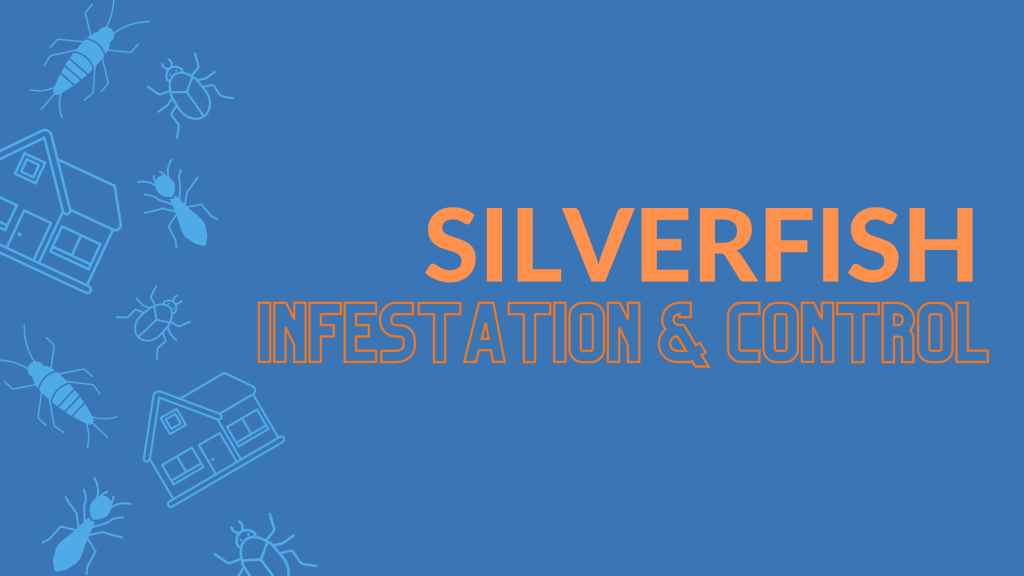Silverfish Infestation & Control

Silverfish Infestation & Control
What are silverfish?
Silverfish are small, wingless insects that are commonly found in dark, damp places such as basements, kitchens, and bathrooms. They have a distinctive, silvery-gray appearance and a tapered, carrot-shaped body that can range in size from 0.5 to 1 inch long. They are commonly known by other names such as “bristletails” or “carpet sharks”.
Silverfish are known for their quick movements and their ability to live for long periods of time without food. They feed on a variety of substances including carbohydrates, such as sugars and starches, and proteins, such as glue, paper, and textiles. They are also attracted to damp or humid areas and can survive in areas with low levels of light.
Silverfish are difficult to control because they can survive for long periods without food, and they can reproduce quickly. However, there are a number of methods for preventing and controlling silverfish infestations.
Tips To Prevent Silverfish In Your Home
- Reduce humidity levels: Silverfish thrive in damp environments, so it’s important to keep the humidity levels in your home low. Use a dehumidifier or air conditioner to keep the air dry.
- Repair leaks: Silverfish are attracted to moisture, so it’s important to fix any leaks in your home, such as leaky pipes or faucets.
- Seal cracks and crevices: Silverfish can enter your home through small cracks and crevices. Seal these openings with caulk or weatherstripping.
- Store food properly: Silverfish are attracted to food sources such as grains, cereals, and pet food. Store these items in airtight containers to prevent silverfish from accessing them.
- Keep your home clean: Regularly vacuum and sweep your floors to remove crumbs and other food sources that may attract silverfish.
- Remove clutter: Silverfish like to hide in clutter, so it’s important to keep your home tidy and free of excess clutter.
Are silverfish dangerous?
Silverfish are generally not considered harmful to humans or pets.
They do not bite or sting, and they are not known to transmit diseases. They are primarily considered a nuisance pest because they can damage paper, books, and other materials, and can infest food sources.
In rare cases, some people may be allergic to silverfish, and exposure to their shed skin and waste particles can cause respiratory problems such as asthma or allergies. Additionally, silverfish may attract other pests such as spiders, which can be harmful to humans and pets.
It’s important to prevent silverfish infestations in your home and to take steps to control them if they do appear, to avoid potential damage to property and to prevent attracting other pests that may be harmful to humans or pets.
How to get rid of silverfish
- Use diatomaceous earth: Sprinkle diatomaceous earth in areas where silverfish are present. This substance is made from crushed fossils of aquatic organisms and is abrasive to the exoskeleton of silverfish, causing them to dehydrate and die.
- Apply boric acid: Boric acid is a common insecticide that is effective against silverfish. Apply it to areas where silverfish are present, such as cracks, crevices, and baseboards.
- Use sticky traps: Place sticky traps in areas where silverfish are present. This will help to capture and kill them.
- Vacuum regularly: Vacuuming floors, carpets, and other surfaces regularly can help to remove silverfish and their eggs.
- Remove food sources: Silverfish are attracted to food sources such as grains, cereals, and pet food. Store these items in airtight containers to prevent silverfish from accessing them.
It’s important to note that getting rid of silverfish can be challenging, as they can reproduce quickly and are resistant to some insecticides. If you have a severe silverfish infestation, you may need to contact a pest control professional for help.
How a pest control professional can help eliminate silverfish
- Inspection: A professional will inspect your home to determine the extent of the infestation and identify areas where silverfish are present.
- Treatment: Professional pest control companies use a variety of treatment methods to eliminate silverfish, such as insecticides, baits, and dusts. They may use a combination of methods to achieve the best results.
- Prevention: A professional exterminator can recommend preventive measures to reduce the risk of future silverfish infestations, such as sealing cracks and crevices, reducing humidity levels, and removing food sources.
- Follow-up: Most pest control companies schedule follow-up visits to monitor the effectiveness of the treatment and make any necessary adjustments to ensure that the infestation is completely eliminated.
It’s important to choose a reputable pest control company with experience in treating silverfish infestations. Be sure to ask about the methods they use, their safety precautions, and their guarantee for their services. Additionally, follow any instructions provided by the professional to ensure that the treatment is effective and safe for you, your family, and your pets.
